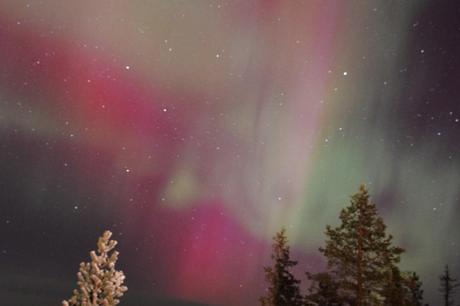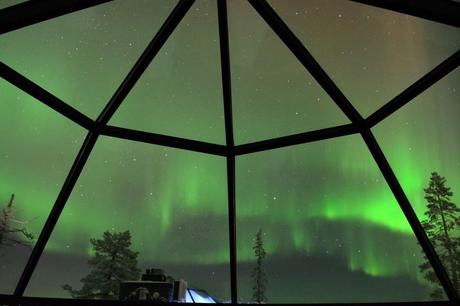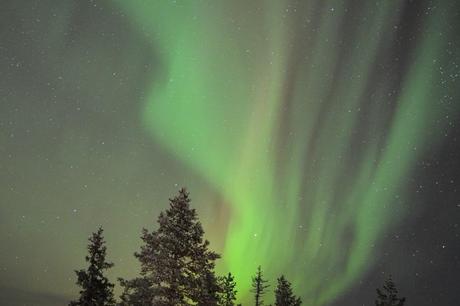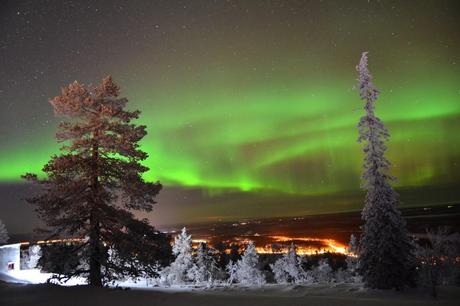Earlier in December, I was witness to the most spectacular sight of my entire life.
The Northern Lights, the Aurora Borealis. For two nights in northern Finland the lights danced, as if straight down from heaven, swirling all across the dark sky. On the second night I stayed in a glass igloo, and what a night it turned out to be. The lights came on in their full splendour; the skies were ablaze with color from night till morning. I watched from the heated interior of my cabin, and even with the clear-glass domed roof, my eyes could not take it all in. And that is the magic of the aurora – as it unfurls before your eyes, you hardly dare blink. As the lights prance across the sky, your heart leaps in time to the movement.




It’s on nearly everyone’s bucket list. You read about it, you see it in videos and pictures, and you tell yourself, I’ve got to go see that one day. Yet few things are more elusive. As I packed for my trip, I was inundated with stories of friends who had made the long and expensive trip up to the Arctic circle only to spend a very cold week staring at the cloudy sky, so it was with a healthy dose of disappointment-preparedness that I set off to the frigid wilderness of the Finnish Lapland. While I eventually got incredibly lucky, there were lots of tips, resources and information that I picked up during my trip which I will attempt to document here. Hopefully it will benefit the aurora hunters, God knows we need all the help we can get!
1. The Aurora Forecast
http://www.gi.alaska.edu/AuroraForecast
Because the aurora is a product of solar winds emitted from the sun, there are reasonably good forecasts available based on knowledge of the sun’s activity, as the solar emissions take about 4 days to reach the Earth. This website is a gem, and on the left column you can pick whichever area of the world you are in (Europe, Alaska, Canada and the South Pole for the Aurora Australis) for the day’s outlook. The forecast even runs about a week in advance so you get some idea about upcoming auroral activity.
2. The weather forecast
Undoubtedly the make-or-break for aurora sightings, you need a reliable weather forecast source for your area. Little to no cloud cover is absolutely necessary for displays. I found yr.no to be a very good meteorological source for the Scandinavian region.
http://www.yr.no/
3. Photographing the lights
You’ll need a tripod. You’ll also need a relatively manual camera. The rules of thumb go as follows: set your ISO to the highest useable level (without it getting too noisy), open up your aperture to the widest it can go, and put your camera on manual focus to infinity. You can then play around with the shutter speed to achieve the effect that you want. A longer shutter will result in a smoother streak of lights, while a shorter shutter will give you a spiky effect. Because the camera is capable of seeing more than the human eye, just keep your camera pointed at the sky, and fire away. Review your images, and make adjustments as necessary. To minimize camera shake, either use a remote shutter release or a 2-second timer.
The cold will do all sorts of crazy things to your camera battery, and it can go from fully charged to empty in 10 minutes. When that happens, hold the battery in your palm or close to your body to warm it up. When you pop it back into the camera it should register as full again.
4. Make your peace with the cold
The cold comes with the aurora, as the lack of cloud cover causes heat to dissipate much more quickly. After the two days of auroral displays, temperatures in Levi, Finland plummeted to below -30 degreesC. Over the next few days as the clouds moved back in, temperatures went up to around a relatively balmy -5 degreesC. If you’re hoping to see the Northern Lights, be prepared to be very very cold.
5. How to thaw out your hands
Being a photographer, frozen hands are a constant problem. you can put on the 12 jackets needed to keep your body warm, but what do you do with your extremities? Mittens will keep your fingers toasty but are useless when it comes to operating your camera. One trick I picked up from a local Sami reindeer herder was to constantly swing your arms to keep warm blood moving. Hold your hands up in front of you level with your shoulders, swing them downwards and repeat until you feel your fingers again. You look silly but it works like nothing else I’ve ever tried.
6. Plan other activities
Part of the mystical allure is that you never know whether or not you will see the northern lights. Of course it is difficult to plan a trip to see the lights and not bank all your hopes on it, but there is plenty to do up in the winter wonderland of the north. Snow-mobiling, dog sledding, reindeer sledding, skiing, snow trekking and the list goes on. If the skies are clear and conditions look good, bundle up and head out for your hunt! I met too many frustrated travellers who didn’t get to see the aurora, which is a shame because the Arctic region is a great travel destination regardless. Don’t let your trip get ruined by the appearance (or non-appearance) of the aurora!

When you do see it, it will be a sight of a lifetime. It is a deeply moving spectacle, and a sobering reminder that there is so so much more going on outside of this little place on which we live. I will never tire of the sight, and would jump at the next opportunity to see one of these displays again. If you are going on an aurora hunt of your own, good luck, and may the odds be ever in your favour!
-Sarah-

